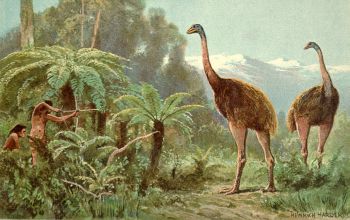Difference between revisions of "Giant Moa"
Tao alexis (talk | contribs) |
Tao alexis (talk | contribs) |
||
| (3 intermediate revisions by the same user not shown) | |||
| Line 1: | Line 1: | ||
| − | [[File:Moa (giant).jpg| | + | {{Bestiarychart |
| − | + | | name = Giant Moa | |
| + | | species = [[Flightless Birds|flightless bird]] | ||
| + | | noapp = 4–16 | ||
| + | | behaviour = herd | ||
| + | | range = [[Rainforest (range)|rainforest]], [[Savanna (range)|savanna]] | ||
| + | | size = 12 ft. tall | ||
| + | | weight = 510 lbs. | ||
| + | | int = 1 | ||
| + | | AC = 7 | ||
| + | | HD = 6 | ||
| + | | AP = 6 | ||
| + | | stride = 23 | ||
| + | | THAC0 = 17 | ||
| + | | hpdie = 2d4 | ||
| + | | attack = kick & peck | ||
| + | | dmg = 2-8 & 2-16 | ||
| + | | special = none | ||
| + | }} | ||
| + | |||
| + | '''Giant moa''' are large beasts, spending most of their day feeding from trees and shrugs. Traditionally, they move with their heads bent over, so that while they can stand at an impressive height, they're able to move through brush and trees with some concealment. They only stand erect when watching for predators; usually one member of a herd will watch while others move and eat. | ||
| + | |||
| + | [[File:Moa (giant).jpg|left|350px|thumb]] | ||
| + | When approached, they will give ground at first while gathering together. The largest male will then stand its ground as the herd's females slip away, running in single file through the bush. This male will fight and hold his ground until the last of his herd has moved off, before falling in line behind them. | ||
| + | |||
| + | The mating season begins in April; usually the primary and secondary males are the only ones who mate. A herd almost always consists of 3 females for every male. Eggs are laid in August and will be defended by the moa female to the death. The eggs are 7 in. long and weigh about 4½ lbs. They're wholly edible and are prized by some [[Tribe|tribal groups]]. Typically 4-5 eggs are laid, with three surviving to become young birds. | ||
| − | |||
| − | |||
| − | |||
| − | |||
See [[Bestiary]] | See [[Bestiary]] | ||
| − | [[Category: | + | [[Category: Don't Review until 2022]][[Category: Animal Intelligence]] |
| − | [[Category: | ||
Latest revision as of 23:06, 22 June 2022
| Species | flightless bird |
| No. Appearing | 4–16 |
| Behaviour | herd |
| Range | rainforest, savanna |
| Size | 12 ft. tall |
| Weight | 510 lbs. |
| Intelligence | 1 |
| Armour Class | 7 |
| Hit Dice | 6 |
| Action Points | 6 |
| Max. Stride | 23 |
| THAC0 | 17 |
| Hp/Die | 2d4 |
| Attack Forms | kick & peck |
| Damage | 2-8 & 2-16 |
| Special Attacks | none |
Giant moa are large beasts, spending most of their day feeding from trees and shrugs. Traditionally, they move with their heads bent over, so that while they can stand at an impressive height, they're able to move through brush and trees with some concealment. They only stand erect when watching for predators; usually one member of a herd will watch while others move and eat.
When approached, they will give ground at first while gathering together. The largest male will then stand its ground as the herd's females slip away, running in single file through the bush. This male will fight and hold his ground until the last of his herd has moved off, before falling in line behind them.
The mating season begins in April; usually the primary and secondary males are the only ones who mate. A herd almost always consists of 3 females for every male. Eggs are laid in August and will be defended by the moa female to the death. The eggs are 7 in. long and weigh about 4½ lbs. They're wholly edible and are prized by some tribal groups. Typically 4-5 eggs are laid, with three surviving to become young birds.
See Bestiary
